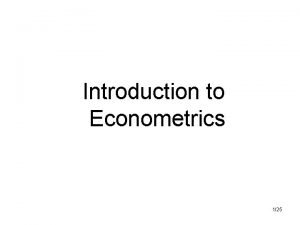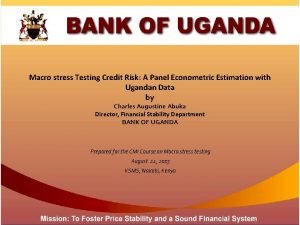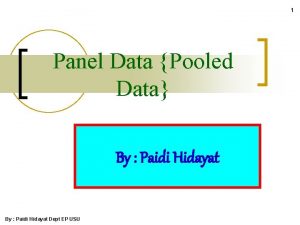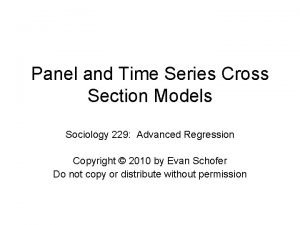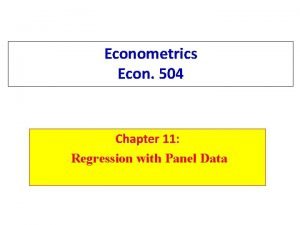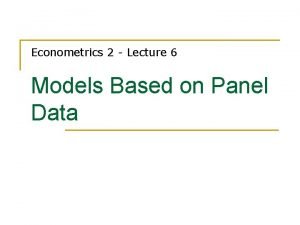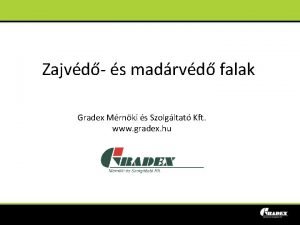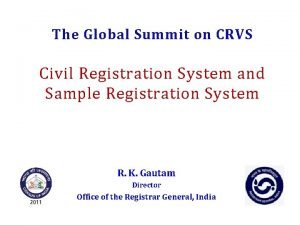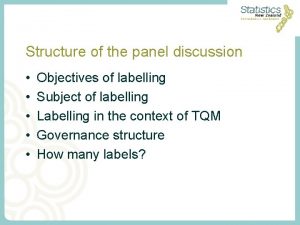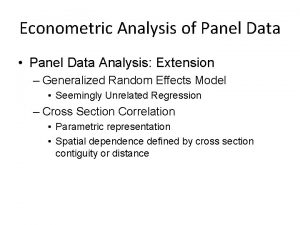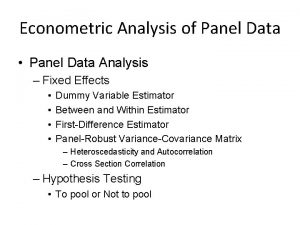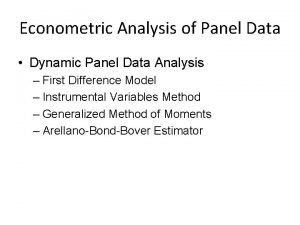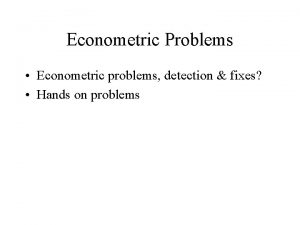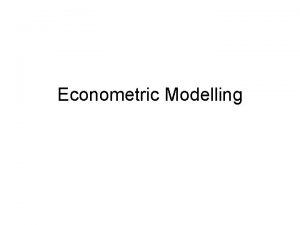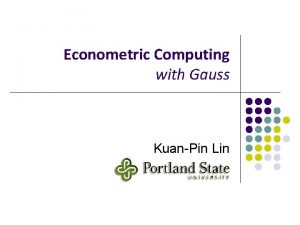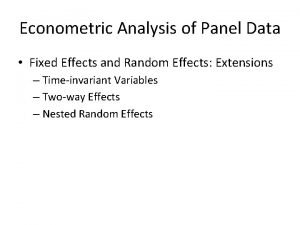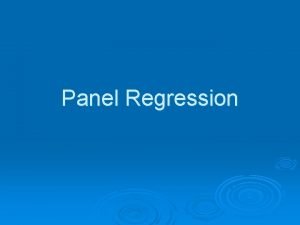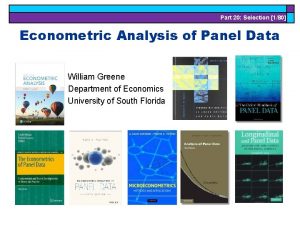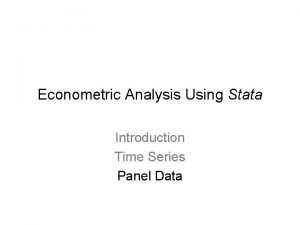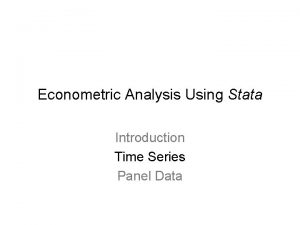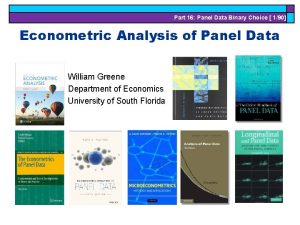Econometric Analysis of Panel Data Panel Data Analysis






















![Example: Investment Demand • Grunfeld and Griliches [1960] – i = 10 firms: GM, Example: Investment Demand • Grunfeld and Griliches [1960] – i = 10 firms: GM,](https://slidetodoc.com/presentation_image/0f07a2714658fa9d875d7c261df18140/image-23.jpg)
- Slides: 23

Econometric Analysis of Panel Data • Panel Data Analysis – Random Effects • • Assumptions GLS Estimator Panel-Robust Variance-Covariance Matrix ML Estimator – Hypothesis Testing • Test for Random Effects • Fixed Effects vs. Random Effects

Panel Data Analysis • Random Effects Model – ui is random, independent of eit and xit. – Define eit = ui + eit the error components.

Random Effects Model • Assumptions – Strict Exogeneity • X includes a constant term, otherwise E(ui|X)=u. – Homoschedasticity – Constant Auto-covariance (within panels)

Random Effects Model • Assumptions – Cross Section Independence

Random Effects Model • Extensions – Weak Exogeneity – Heteroscedasticity

Random Effects Model • Extensions – Serial Correlation – Spatial Correlation

Model Estimation: GLS • Model Representation

Model Estimation: GLS • GLS

Model Estimation: RE-OLS • Partial Group Mean Deviations

Model Estimation: RE-OLS • Model Assumptions • OLS

Model Estimation: RE-OLS • Need a consistent estimator of q: – Estimate the fixed effects model to obtain – Estimate the between model to obtain – Or, estimate the pooled model to obtain – Based on the estimated large sample variances, it is safe to obtain

Model Estimation: RE-OLS • Panel-Robust Variance-Covariance Matrix – Consistent statistical inference for general heteroscedasticity, time series and cross section correlation.

Model Estimation: ML • Log-Likelihood Function

Model Estimation: ML • ML Estimator

Hypothesis Testing To Pool or Not To Pool, Continued • Test for Var(ui) = 0, that is – If Ti=T for all i, the Lagrange-multiplier test statistic (Breusch-Pagan, 1980) is:

Hypothesis Testing To Pool or Not To Pool, Continued – For unbalanced panels, the modified Breusch. Pagan LM test for random effects (Baltagi-Li, 1990) is: – Alternative one-side test:

Hypothesis Testing To Pool or Not To Pool, Continued • References – Baltagi, B. H. , and Q. Li, A Langrange Multiplier Test for the Error Components Model with Incomplete Panels, Econometric Review, 9, 1990, 103 -107. – Breusch, T. and A. Pagan, “The LM Test and Its Applications to Model Specification in Econometrics, ” Review of Economic Studies, 47, 1980, 239 -254.

Hypothesis Testing Fixed Effects vs. Random Effects Estimator Random Effects E(ui|Xi) = 0 Fixed Effects E(ui|Xi) =/= 0 GLS or RE-OLS (Random Effects) Consistent and Efficient Inconsistent LSDV or FE-OLS (Fixed Effects) Consistent Inefficient Consistent Possibly Efficient

Hypothesis Testing Fixed Effects vs. Random Effects • Fixed effects estimator is consistent under H 0 and H 1; Random effects estimator is efficient under H 0, but it is inconsistent under H 1. • Hausman Test Statistic

Hypothesis Testing Fixed Effects vs. Random Effects • Alternative (Asym. Eq. ) Hausman Test – Estimate any of the random effects models – F Test that g = 0

Hypothesis Testing Fixed Effects vs. Random Effects • Ahn-Low Test (1996) – Based on the estimated errors (GLS residuals) of the random effects model, estimate the following regression:

Hypothesis Testing Fixed Effects vs. Random Effects • References – Ahn, S. C. , and S. Low, A Reformulation of the Hausman Test for Regression Models with Pooled Cross-Section Time-Series Data, Journal of Econometrics, 71, 1996, 309 -319. – Baltagi, B. H. , and L. Liu, Alternative Ways of Obtaining Hausman’s Test Using Artificial Regressions, Statistics and Probability Letters, 77, 2007, 1413 -1417. – Hausman, J. A. , Specification Tests in Econometrics, Econometrica, 46, 1978, 1251 -1271. – Hausman, J. A. and W. E. Taylor, Panel Data and Unobservable Individual Effects, Econometrics, 49, 1981, 1377 -1398. – Mundlak, Y. , On the Pooling of Time Series and Cross-Section Data, Econometrica, 46, 1978, 69 -85.
![Example Investment Demand Grunfeld and Griliches 1960 i 10 firms GM Example: Investment Demand • Grunfeld and Griliches [1960] – i = 10 firms: GM,](https://slidetodoc.com/presentation_image/0f07a2714658fa9d875d7c261df18140/image-23.jpg)
Example: Investment Demand • Grunfeld and Griliches [1960] – i = 10 firms: GM, CH, GE, WE, US, AF, DM, GY, UN, IBM; t = 20 years: 1935 -1954 – Iit = Gross investment – Fit = Market value – Cit = Value of the stock of plant and equipment
 Methodology of econometric analysis
Methodology of econometric analysis Continuous panel vs discontinuous panel
Continuous panel vs discontinuous panel Zıt panel nedir
Zıt panel nedir Hausman test
Hausman test Panel data
Panel data Xttest
Xttest Panel veri analizi örnekleri
Panel veri analizi örnekleri Contoh panel data
Contoh panel data Xtsum stata
Xtsum stata Panel data
Panel data Time fixed effects
Time fixed effects Panel data
Panel data Panel data
Panel data Unbalanced panel data stata
Unbalanced panel data stata Sources of content analysis
Sources of content analysis Data collection procedure
Data collection procedure Data preparation and basic data analysis
Data preparation and basic data analysis Data acquisition and data analysis
Data acquisition and data analysis Alto zajvédő panel
Alto zajvédő panel Chemetron medical gas alarm panel
Chemetron medical gas alarm panel Infant death rate
Infant death rate Arcp panel
Arcp panel Pys tübitak
Pys tübitak Objectives of panel discussion
Objectives of panel discussion
